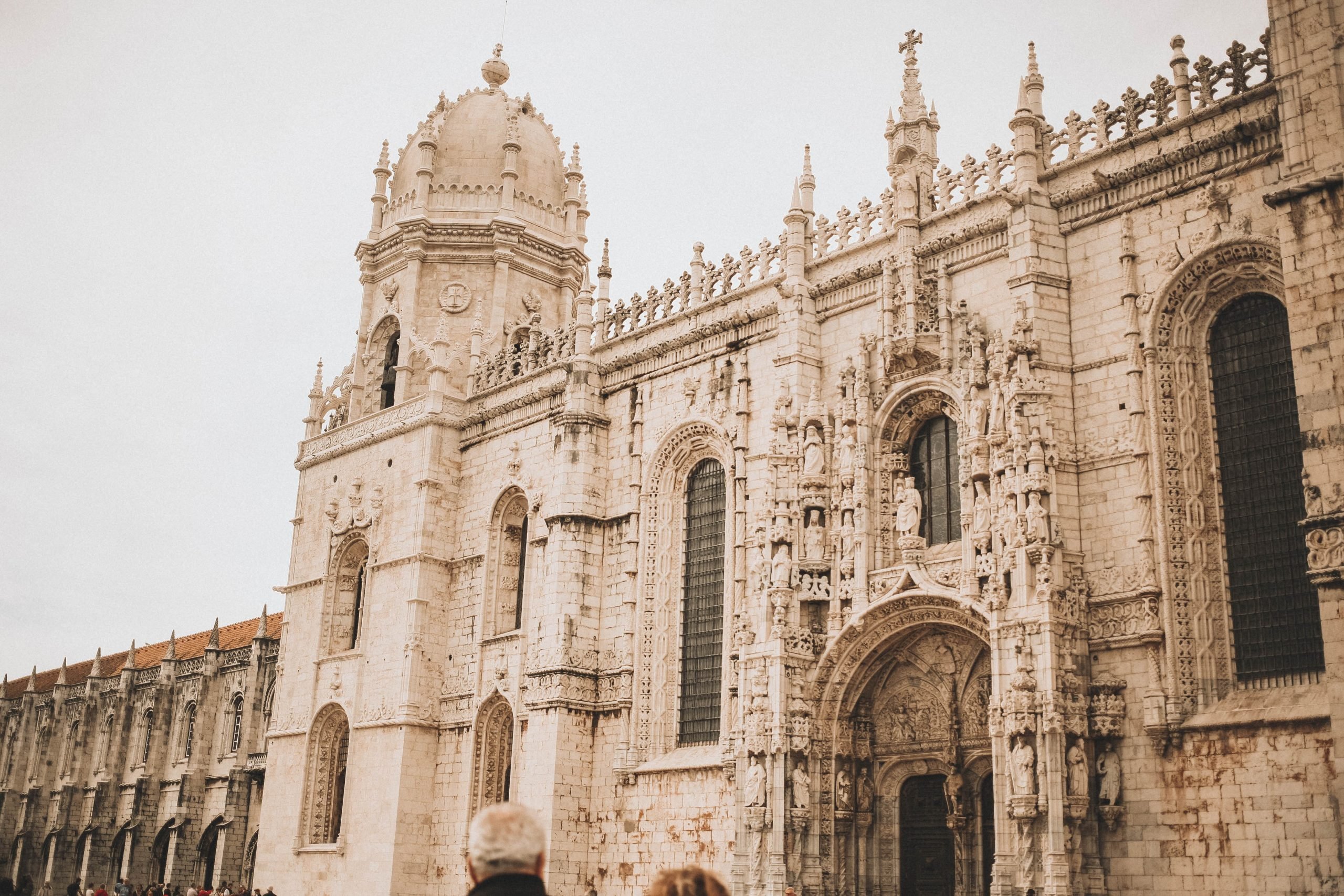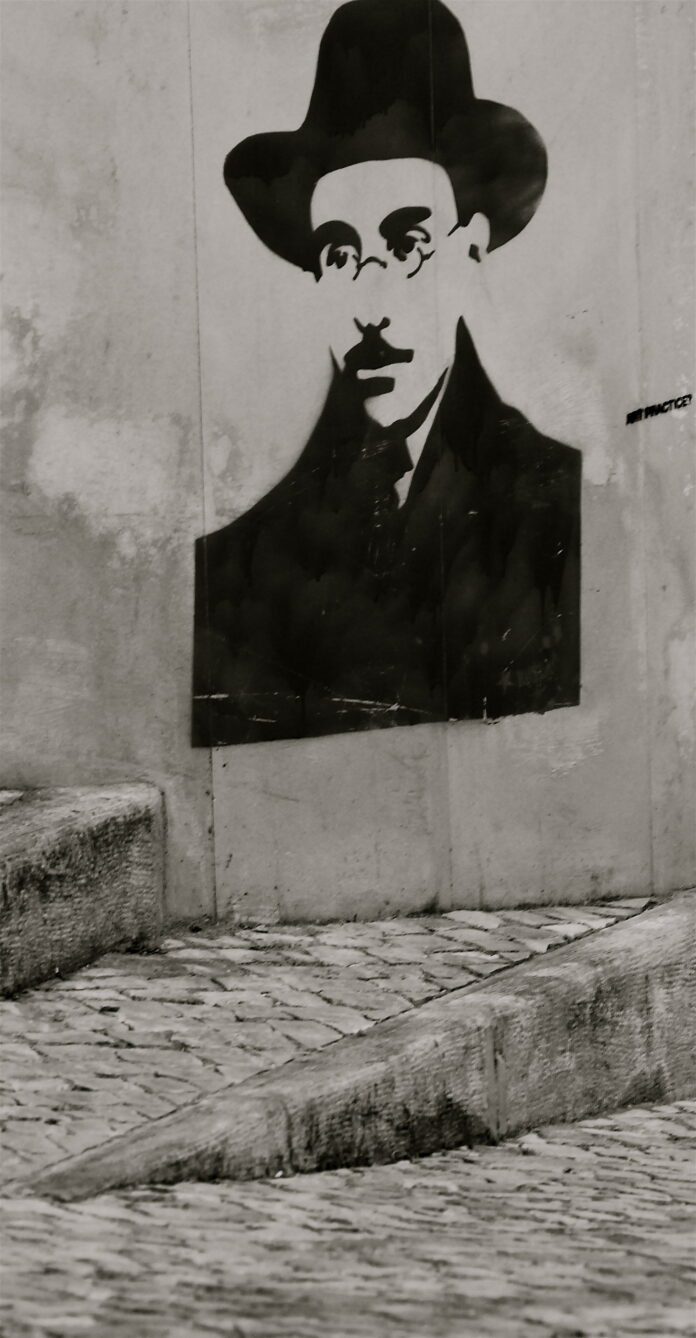If you’re a bibliophile coming to Lisbon (even more so if you’re a bibliophile passionate about classic authors!), you’re probably planning to learn about Fernando Pessoa, Portugal’s most famous and loved author, as much as you can.
If so, you’ve arrived where you’re expected! We’ve prepared a complete guide for tourists who want to overwhelm themselves with details of Pessoa’s life, thoughts, and books!
We’ll start with some information about Fernando Pessoa, then continue our journey by discussing the iconic Casa Fernando Pessoa and other places that will retrace his steps throughout Lisbon – from the cafe where he had his daily coffee to where Fernando Pessoa is buried.
Who Was Fernando Pessoa?
Before discussing Casa Fernando Pessoa, why not travel back in time and meet Fernando Pessoa ourselves?
Born in Lisbon in 1888, Fernando Pessoa had quite a tragic childhood. When he was only five years old, his father died of tuberculosis. Less than a year later, Pessoa lost his younger brother.
After these losses, Pessoa and his mother, who had remarried, moved to South Africa in 1896. The fact that his stepfather was the Portuguese consul in Durban ensured that Pessoa received a good education, particularly in learning English.
Fernando Pessoa’s classmates recalled that he was a very pale, thin, and ill-looking boy, yet a very clever pupil, possibly the cleverest in their class. Although he had never spoken English before arriving there, Pessoa learned it quickly, achieving a higher level than his classmates.
Over the time spent at the Durban High School, Pessoa started showing interest in English literature. Some classmates recall that he spent all his spare time reading, never showing interest in sports or anything else popular among other pupils.
While in Durban, Pessoa tried his hand at writing short stories in English. His first poem entitled “Hillier did first usurp the realms of rhyme…” was published in 1904. Over the next year, Pessoa published other pieces. The young writer was already using pen names, including Charles Robert Anona, David Merrick, Chevalier de Pas, and Horace James Father. These “exercises” paved the way to constructing his famous heteronyms.
Pessoa did not stay in Durban for too long. Only ten years later, when he was 17, the poet decided to return to Lisbon to study and, since then, rarely left the city. However, his studies were cut short as a consequence of a student strike, so Pessoa turned to self-teaching.
Over the years, he set up his own publishing house, founded an art journal, and published his works extensively, earning his sacred place in the literary world of Lisbon.
The writer moved from one place to another in Lisbon quite frequently. In 1920, however, he settled in what would soon become the Fernando Pessoa Museum, also known as Casa Fernando Pessoa. He and his family lived on the first floor of a building located at 16, Rua Coelho da Rocha, Campo de Ourique. According to historians, this was the 16th place he lived in! He remained there until his death in 1935.
Casa Fernando Pessoa History
After Fernando Pessoa’s death, his apartment and others in the building were rented or owned by several people. However (and luckily for us, book lovers!), the Lisbon Municipal Council decided to purchase the building at the end of the 1980s and transform it into a museum.
At the time, the building was on the brink of collapsing. Considering that it had been Fernando Pessoa’s last address and the place where he had put his creativity at work, the city did not want to risk the building being demolished, so they purchased it and made it into a place that commemorates Pessoa’s work.
The Lisbon Municipal Council reconstructed the whole building, except for Pessoa’s apartment, which was left unchanged. The original facade and the stairs leading to Pessoa’s apartment were also preserved. An auditorium, a library, and a multimedia room were established.
Casa Fernando Pessoa was inaugurated on the 30th of November 1993, 58 years after the writer’s death. The building is now considered a National Treasure of Portugal, and it welcomes hundreds of thousands of visitors from all over the world who have already read or are about to immerse themselves in Fernando Pessoa’s writings that explore the depths of the human being in a rather melancholic manner.
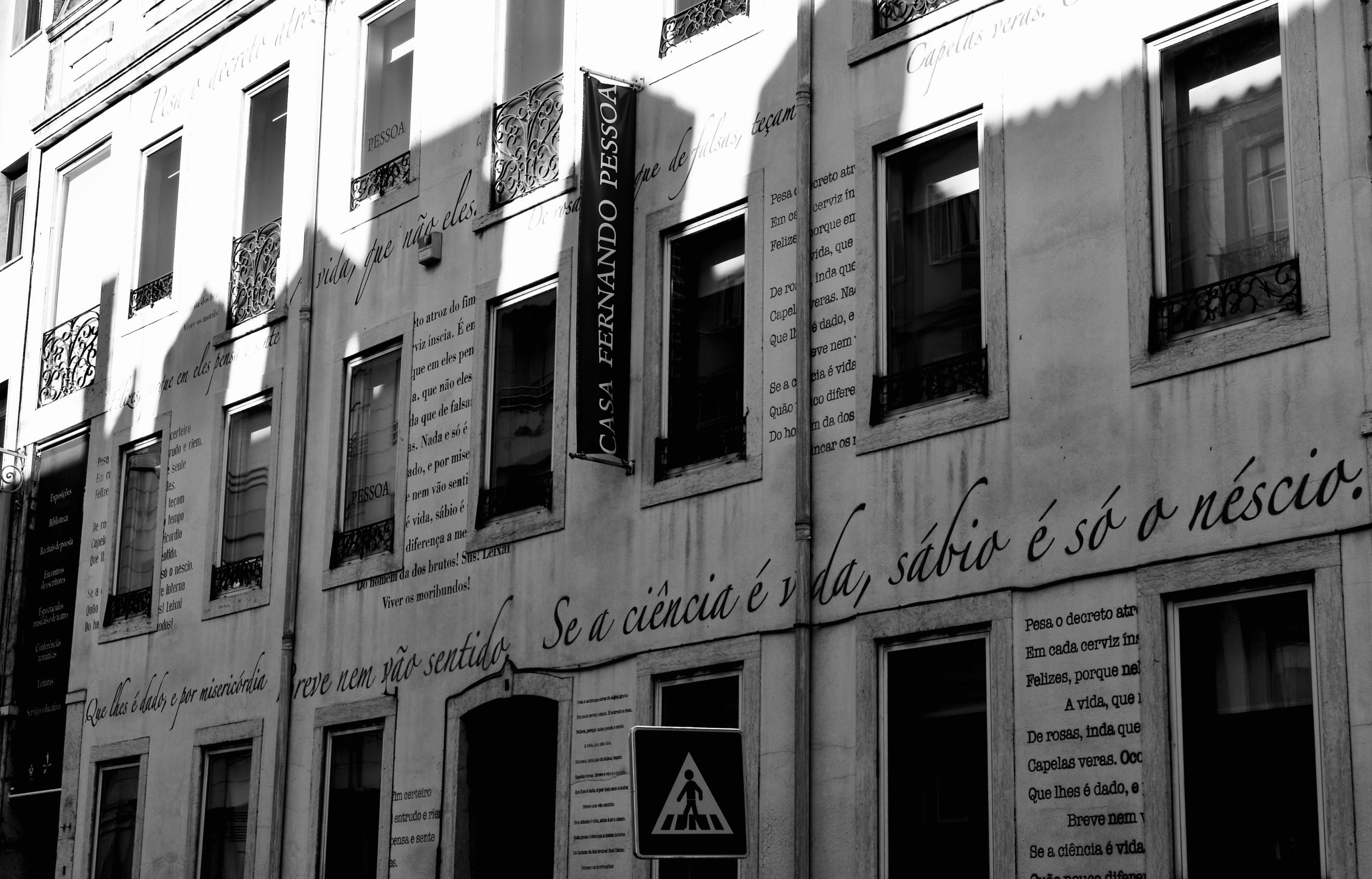
Why Visit Casa Fernando Pessoa?
Whether you’ve read anything about Pessoa, are a dedicated fan of his writings, or never even heard about him – you’ll probably enjoy Casa Fernando Pessoa if you’re a bibliophile.
Stepping inside the museum will absorb you into an enchanting journey through time that will instantly take you back to the 1920s, wandering through Pessoa’s mind, trying to grasp even a little bit of what he thought, saw, read, and wrote.
Fernando Pessoa’s Personal Library
What book lover won’t enjoy seeing the very books that Fernando Pessoa owned? This is, in fact, the museum’s largest and most sacred collection that helps visitors get lost in the writer’s inner world while guessing which was his favorite and least favorite book. You’ll also be able to see the comments and marks Pessoa left in his books.
In addition, the museum has on display multiple translations of Pessoa’s works. So, if you’ve never read his poems, now you have the chance to see if his style is something you may enjoy. Who knows, maybe you’ll be on your way to discovering your next favorite writer?!
Long-Term Exhibition
Casa Fernando Pessoa has a long-term exhibition equipped with informative material in English that allows visitors to delve into the writer’s life. The museum’s cultural mediators invite everyone to discover Pessoa’s universe in English, Spanish, German, and French.
The long-term exhibition offers a more intimate glimpse into the life of the poet known as the master of heteronyms. The exhibition spans over three floors, each shaped as a chapter. The staff recommends visitors to start the journey from the third floor and then go downstairs to the other rooms.
The most iconic room that can impress any bookworm is dedicated to Pessoa’s heteronyms – a comprehensive representation of Pessoa’s masterful play with names and characters. This particular room is also home to the most famous painting executed by Pessoa’s friend – the Portuguese painter Almada Negreiros.
If you think that’s exciting enough for you to buy your plane ticket right now, wait until you hear this: the exhibition allows visitors to listen to the poems written by Pessoa. How amazing is that?! What better way to fully get lost in Pessoa’s reality and explore his universe if not by actually listening to a skillful reciting of his texts?!

Fernando Pessoa’s Personal Objects
Seeing your favorite writer’s personal objects from up-close is any reader’s dream, isn’t it?! It feels like you’ve stepped onto an otherworldly realm, being overwhelmed by the rapid passage of time – are you still in the present, or have you left for the 1920s, sitting next to Fernando Pessoa and asking him about some of his most precious possessions?
The Library
Casa Fernando Pessoa isn’t only a museum. It also has a library open to those who want to read and study in a more special atmosphere.
The library focuses on Pessoa’s writings, having an extensive collection of his books and their translations. You’ll also find sections dedicated to other poets from around the world.
The library is open from 10 am to 6 pm every day except weekends and Mondays.
The Shop
Are you about to leave Portugal, but you haven’t found the perfect souvenir yet? You’ll probably find something at the shop in Casa Fernando Pessoa.
It has all his books in several editions and languages, as well as themed bags and cork-made products created by the museum’s exclusive line.
The shop is open from Tuesday to Sunday, from 10 am to 6 pm.
The Restaurant
Nothing beats enjoying a Portuguese-flavored espresso or maybe even a lunch filled with the country’s gastronomic secrets at the Flagrante Delistro restaurant. Is there a better way to finish your tour through Pessoa’s house?!
The restaurant is open from Tuesday to Saturday from 10 am to 10 pm. On Mondays, the restaurant is open only until 6 pm.
Lisbon Revisited: Poetry Days
If you’re lucky enough, your trip to Lisbon may match the dates of the literary festival promoted by Casa Fernando Pessoa – Lisbon Revisited: Poetry Days.
The first edition of the festival took place in 2018. Since then, it has returned yearly, offering literary enthusiasts the perfect atmosphere to grasp the guest poets’ inner worlds, learn about their writing processes, and listen to their poems.
In 2023, the festival invited Simon Armitage, Kwame Daws, Halyna Kruk, Chus Pato, Andreia C. Faria, Hélia Correia, Pedro Mexia, and João Luís Barreto Guimarães.
Casa Fernando Pessoa Hours and Prices
Casa Fernando Pessoa is open every day except Monday from 10 am to 6 pm. You’ll need to dedicate approximately an hour for the tour.
The staff recommends visitors to buy their tickets beforehand online to avoid wasting too much time waiting in line. Tickets can be bought from blueticket.meo.pt.
The full ticket costs only 5 EUR – a somewhat insignificant fee for an experience that will imbue your travel journey with lifetime memories!
If you’re visiting Portugal with your children, they can enter without any fees as long as they’re under 12. Visitors between 13 and 25 years old pay only 2.5 EUR.
In addition, if you’re a journalist, researcher, or teacher visiting for professional purposes, you do not have to pay the entrance fee.
Remember that people asking for a reduced fare or free admission have to present proof.

How to Get to Casa Fernando Pessoa
Casa Fernando Pessoa (Rua Coelho da Rocha, 16-18, Campo de Ourique) is located close to Jardim da Estrela. You can get there either by using the yellow metro line, stopping at the Rato station. From there, it will take you approximately 15 minutes by foot to arrive at the museum. You won’t have time to get bored though! Lisbon is full of (hidden) surprises!
You can also take bus 709 from Restauradores Square, tram 25 from Figueira Square, or tram 28 from Martim Moniz Square.
However, if you’re not staying too far away, we’ll always recommend going by foot, even if it takes an hour. Lisbon is a charming city in itself – the buildings, the uniform architecture, and the gems no one talks about on the Internet because they’re only visible to the present eye.
Reaching Casa Fernando Pessoa by foot will be a tour in itself that will show you the most authentic parts of the city – some of them seen and enjoyed by Pessoa himself!
Other Landmarks in Lisbon for Fernando Pessoa Fans
Have you enjoyed Pessoa’s house and want to explore the depths of his universe further? Luckily, the city of Lisbon has guessed you may want to! Portuguese people take great pride in their writers’ work, which is why Lisbon is a rather extensive Fernando Pessoa museum. So what else is there to visit? Let’s see!
Cafe A Brasileira and Pessoa’s Statue
After visiting Casa Fernando Pessoa, head to the district of Chiado to see his statue next to the Cafe A Brasileira – one of Lisbon’s oldest and most iconic cafes that once was the primary meeting point for the Portuguese artists, writers, and free-thinkers.
Cafe A Brasileira was also the gathering spot of the Orpheus’ Group, which Fernando Pessoa was part of. Their goal was to subvert and scandalize Portuguese social conventions. Today, the coffee shop has become one of the most famous tourist spots in the city, which is why it’s usually quite crowded and you may have to wait in line to get a table. However, it’s absolutely worth the time!
If you choose to enjoy your coffee and pastel de nata outside, you’ll delight in the building’s exterior and intricate facade. If you get a table inside, your eyes and aesthetic buds will thank you just as much after unraveling its beauty – mosaicked floors, marble tiles, square pillars along the walls, sculpted wood, and mirrors in between pillars.
Just outside the cafe, Fernando Pessoa’s statue sitting at a table invites the visitors to have a coffee with the poet who lives within his readers’ hearts.

Largo de São Carlos Fernando Pessoa Statue
Another statue honoring Fernando Pessoa is located on Largo de São Carlos 16 because the poet was born in a flat right across the São Carlos National Theatre. The statue was inaugurated in 2008 to commemorate Pessoa’s 120th birthday.
It is located right next to Simpli Coffee Chiado. You can order a cappuccino, espresso, or any other drink of your preference, open Pessoa’s Book of Disquiet, and explore its universe alongside the author’s statue. Quite a poetic atmosphere, don’t you think?
Largo do Carmo
Fernando Pessoa lived at number 18 on Largo do Carmo Square, possibly between 1908 and 1912. At the time, he started translating English and Spanish books into Portuguese for Biblioteca Internacional de Obras Famosas.
Nowadays, Largo do Carmo is one of the most popular spots in Lisbon – it was even the scene of several film and documentary shootings!
In the spring, Largo do Carmo is adorned with mesmerizing blossoming purple jacarandas, a beautiful tree species that awakens the country with its vibrant colors! No wonder Pessoa chose to live there!
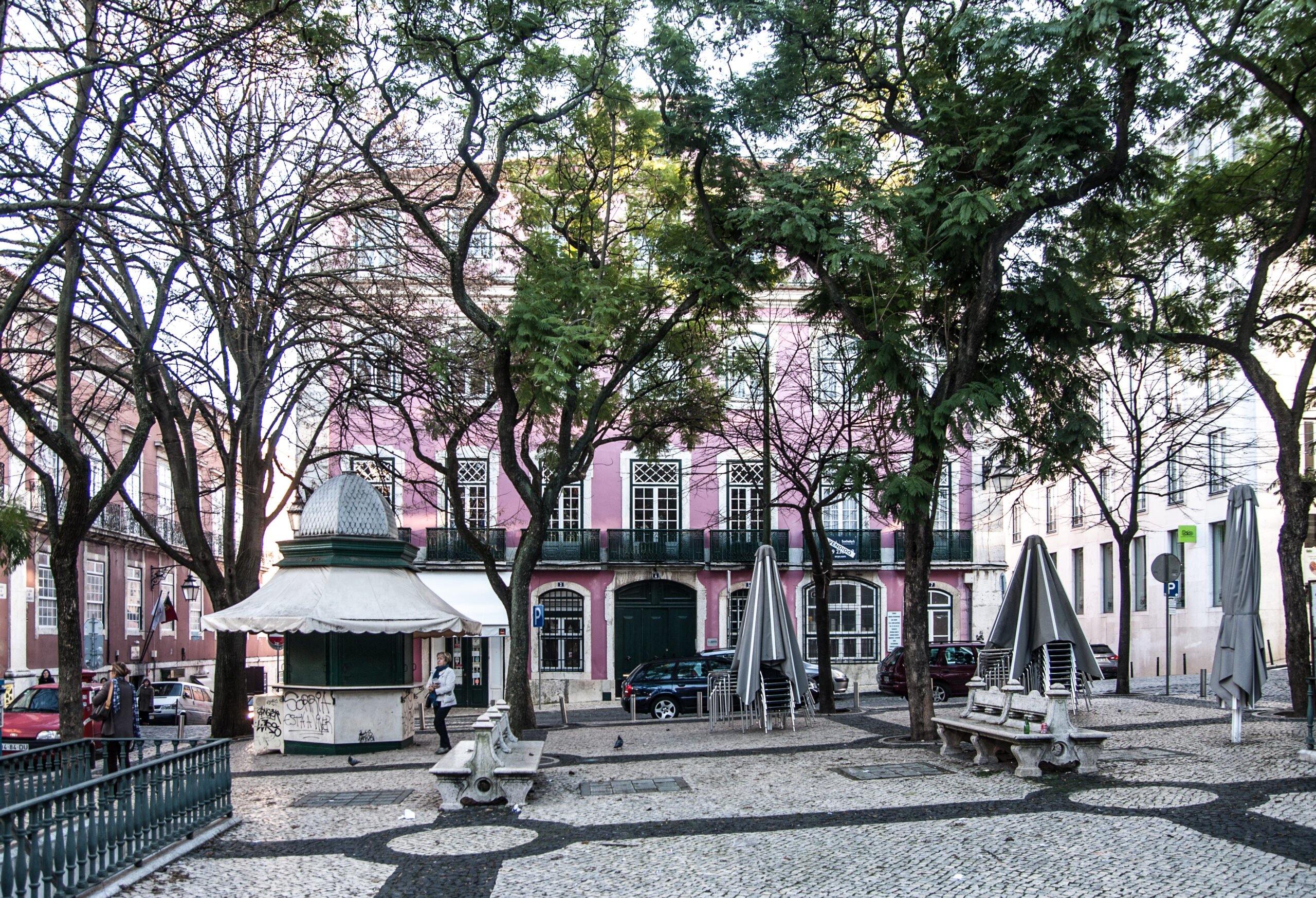
Basílica de Nossa Senhora dos Mártires
If you want to return even further back in time, you should definitely visit Basílica de Nossa Senhora dos Mártires (Basilica of Our Lady of the Martyrs), where Fernando Pessoa was baptized on the 21st of July 1888.
Located on Rua Serpa Pinto 10D, this Catholic church stands as proof of the country’s resilience. It dates from 1147 when it was only a small chapel meant to house the image of the Virgin and commemorate the soldiers who had died in combat.
In 1755, it was completely destroyed by the most destructive earthquake Lisbon had ever registered. Thirty years later, the church was reconstructed in a baroque and late neoclassical style.
Martinho da Arcada
Located in Praça do Comércio, Martinho da Arcada opened its doors to locals in 1782 (officially, because the local had been in place since 1778, known as Cafe do Gelo).
Since its official inauguration, the cafe acquired various names – Casa do Cafe Italiano, Cafe do Comercio, Cafe dos Jacobinos, Casa da Neve, and Cafe da Arcada do Terreiro do Paco. Today, Martinho da Arcada is considered Lisbon’s oldest, still-operating cafe and is classified as a property of public interest by the Portuguese Institute of Architectural Heritage.
Like Cafe A Brasileira, Martinho da Arcada was a popular gathering spot for Lisbon’s artists and writers. However, Fernando Pessoa stands out among all, as he was the most frequent customer – today, he has a permanently reserved table in the restaurant.
It is believed that Pessoa served his coffee there regularly until he died in 1935. Apparently, he had had his last coffee at Martinho da Arcada with Almada Negreiros, a Portuguese artist, only three days before he died.
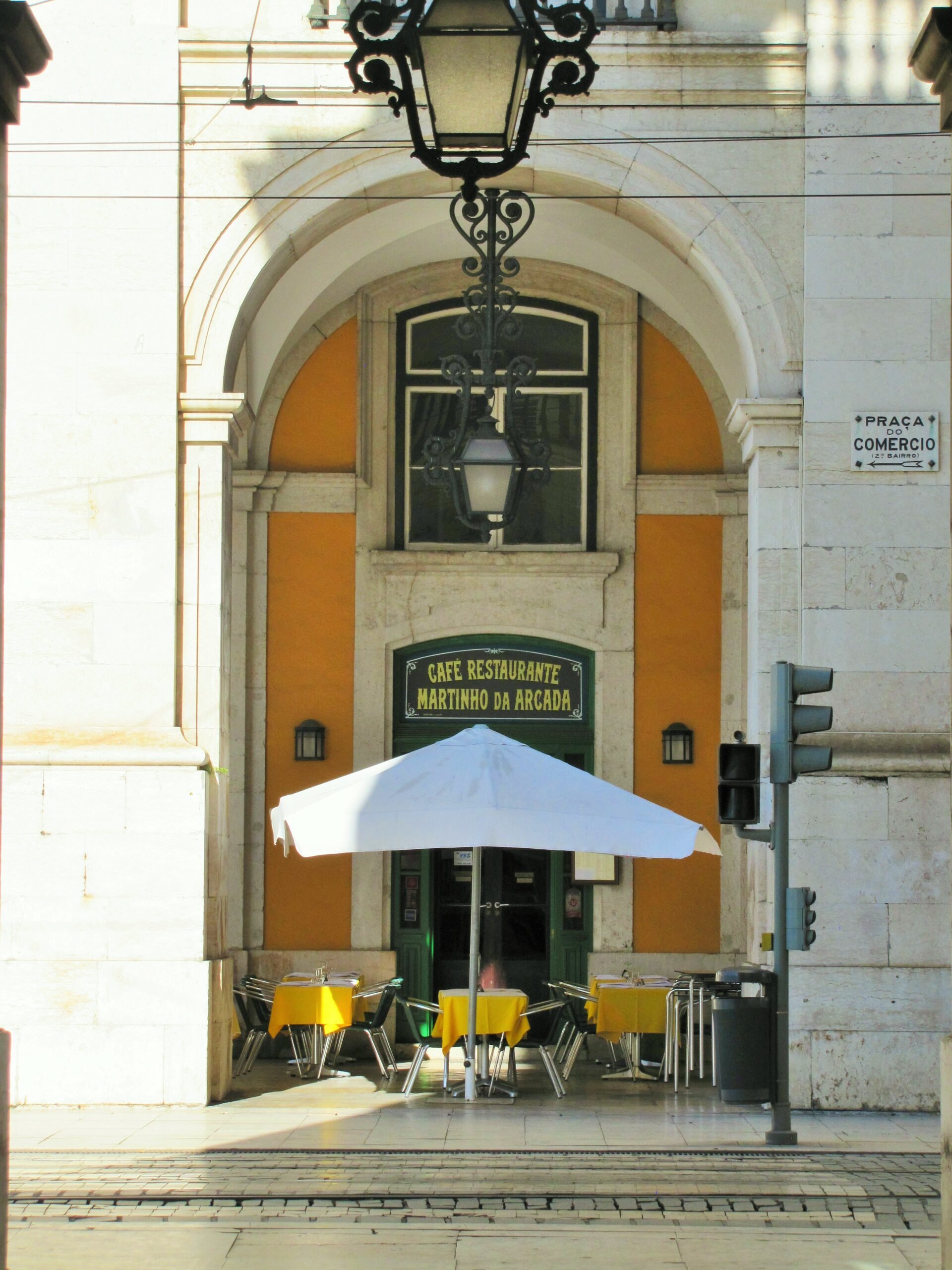
Jeronimos Monastery
Jeronimos Monastery, located in Belem, is the region’s most iconic landmark and the country’s most representative building of the Portuguese Manueline style.
It is now the resting place of Fernando Pessoa. Vasco da Gama, Alexandre Herculano, and Luís de Camões are also buried there.
As such, we definitely recommend adding this landmark to your must-visit list – coming to Portugal without delving into the intricacy of the building’s ornamentations and history makes for an incomplete trip!
